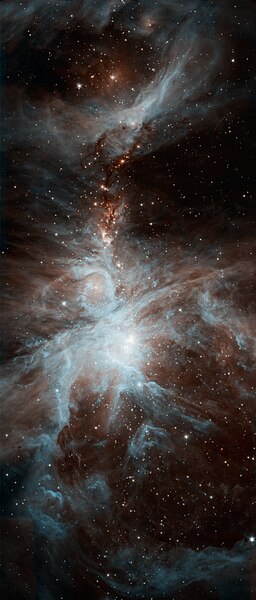Fayl:Spitzer's Orion.jpg

Size of this preview: 256 × 600 pixels. Başqa çözüm: 102 × 240 pixels | 205 × 480 pixels | 328 × 768 pixels | 437 × 1.024 pixels | 2.171 × 5.085 pixels.
Kerçek fayl (2.171 × 5.085 piksel, fayl büyükligi: 1,44 MB, MIME çeşiti: image/jpeg)
Faylnıñ keçmişi
Faylnıñ kerekli anki alını körmek içün tarihqa/saatqa basıñız.
| Tarih ve saat | Kiçik resim | En × boy | Qullanıcı | İzaat | |
|---|---|---|---|---|---|
| şimdiki | 10:31, 2010 s. aprelniñ 10 |  | 2.171 × 5.085 (1,44 MB) | Originalwana | {{Information |Description={{en|1=A colony of hot, young stars is stirring up the cosmic scene in this new picture from NASA's Spitzer Space Telescope. The image shows the Orion nebula, a happening place where stars are born. The young s |
Fayl qullanıluvı
Bu saife qullana bu fayldı:
Umumiy fayl qullanıluvı
Bu vikilerde bu fayldı qullana:
- ba.wikipedia.org qullanım
- bn.wikipedia.org qullanım
- cv.wikipedia.org qullanım
- el.wikipedia.org qullanım
- en.wikipedia.org qullanım
- fa.wikipedia.org qullanım
- سحابی شکارچی
- ویکیپدیا:نگارههای پیشنهادی/ستارهشناسی
- ویکیپدیا:نگاره روز/اکتبر ۲۰۱۳
- کاربر:MMjex/نگارههای برگزیده
- ویکیپدیا:گزیدن نگاره برگزیده/مه-۲۰۱۳
- ویکیپدیا:گزیدن نگاره برگزیده/Spitzer's Orion.jpg
- الگو:نر/2013-10-30
- الگو:نر محافظت شده/2013-10-30
- بحث کاربر:MMjex/بایگانی ۱
- ویکیپدیا:نگارههای برگزیده/نگاه به فضا
- fr.wikipedia.org qullanım
- hu.wikipedia.org qullanım
- is.wikipedia.org qullanım
- it.wikipedia.org qullanım
- ko.wikipedia.org qullanım
- krc.wikipedia.org qullanım
- lbe.wikipedia.org qullanım
- mk.wikipedia.org qullanım
- my.wikipedia.org qullanım
- no.wikibooks.org qullanım
- os.wikipedia.org qullanım
- pl.wikipedia.org qullanım
- ro.wikipedia.org qullanım
- ru.wikipedia.org qullanım
- ru.wikinews.org qullanım
- sah.wikipedia.org qullanım
- sr.wikipedia.org qullanım
- uk.wikipedia.org qullanım
- vi.wikipedia.org qullanım
- xal.wikipedia.org qullanım
- zh.wikipedia.org qullanım




